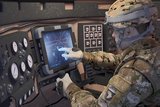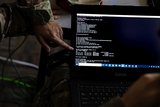The power of AI brought to the tactical edge (Studio)
Brought to you in partnership with Systel
Systel, Inc.’s new Kite-Strike rugged mission computer is designed for a rapidly-changing military market, where technologies such as artificial intelligence (AI) play a crucial role in harnessing the growing power of data.
Kite-Strike is the latest in Systel’s Strike product family of fully rugged mission computers, along with the Hawk-Strike and Raven-Strike product lines.
Set for release in November, Kite-Strike is a next-generation embedded edge supercomputer aimed at a range of military vehicles, along with multiple use cases in the commercial sector.
The system integrates the NVIDIA Jetson AGX Xavier system-on-module (SOM) and is ‘purpose-built for deployment in harsh environments for demanding AI, Deep Learning and Machine Learning (DL/ML) vision applications’, according to Systel.
Kite-Strike’s hardware can support numerous applications in these areas, depending on customer need, explained Aneesh Kothari, Systel’s vice president – marketing.
The current and next generation of vehicles – for all services and in all domains – exploit a wide range of cameras and other sensors to boost their situational awareness, detect incoming threats and improve their performance in other ways.
For example, a combat vehicle could have EO/IR cameras, hostile fire detection systems and more.
‘They’re getting more networked all the time,’ Kothari said. ‘An incredible amount of data is now being captured every millisecond and needs to be processed and acted on at real-time speeds.’
This data must be collected in its raw form, before being intelligently analysed to provide support for near real-time decisions.
The amount of raw data generated today is overwhelming for a human operator to use for real-time decision-making, Kothari noted. That’s where AI functionality comes in – and the right hardware to support it.
Such hardware must be capable of performing fully contained at the edge on the battlefield, without relying on cloud infrastructure to back it up.
This demand was central to the development of Kite-Strike, with the NVIDIA Jetson AGX Xavier SOM allowing for superior, independent performance at low size, weight and power (SWaP) demands, while being ruggedised for the harshest environments.
AI offers a number of other significant benefits for militaries, with these opportunities only set to grow in the coming years.
For example, Kothari pointed to facial recognition and target identification algorithms: this could be used to analyse the raw data from a vehicle’s cameras, perhaps even identifying a suspect from an IED incident in a crowd of people, for instance, or distinguishing between threats such as an incoming projectile versus non-threats such as a bird.
Kothari sees such work as a strong example of manned-unmanned teaming (MUM-T). This will be key to the future battlefield, as humans and machines interact and cooperate more extensively.
Hardware must be capable of processing the data loads required. Humans will remain ‘in the loop’ – for example, they will be essential in “kill chain” types of decisions – but AI can offload some of the burden, pursuing the data fusion and analysis tasks that are essential when dealing with so much information.
‘All of the upfront analysis and data crunching can be done somewhere else,’ Kothari said.
While Kite-Strike is a significant enabler for such technologies on manned platforms, Systel also sees major potential in the unmanned market, in unmanned aerial vehicles (UAVs) and unmanned ground vehicles (UGVs).
Kothari pointed to the robotic combat vehicles element of the US army’s Next Generation Combat Vehicle (NGCV), one of the six modernisation priorities for the service. Such unmanned systems will rely on cameras, EO/IR, FLIR, LIDAR and other sensors, he said.
‘In order to be unmanned, by definition you must have these various sensors, because that's what's capturing and feeding the data into the AI engine to make intelligent decisions,’ he said.
UGVs and UAVs by their nature are smaller than manned vehicles and can operate in harsher environments of extreme heat or cold, thanks to the absence of human crew members.
Their electronic and other components must be capable of surviving and thriving under such conditions. This was a core consideration for Systel in designing Kite-Strike, with the rugged computer capable of functioning in temperatures ranging from minus 40 degrees Celsius to plus 65 degrees.
It is also designed to operate in high altitude and endure extreme shock and vibration, Kothari noted, all with SWaP-demands kept in mind, particularly when it comes to the system’s use in smaller platforms.
Kothari emphasised the need for configurability and modularity in mission computers like Kite-Strike, which was designed to avoid a ‘one size fits all’ mindset.
‘From vehicle to vehicle, application to application, customer to customer, you have different requirements and different needs,’ Kothari explained.
‘For example, perhaps the ruggedisation needs or the SWaP needs will be the same for two platforms, or the core technology needs, but our system would need to ingest different camera formats and different camera types.’
The system can be easily configured, he said, and can accommodate scaling requirements sets in a modular fashion. This is based on commercial off the shelf (COTS) proven technology, he added, ‘so it’s very reliable, very low risk, and has a very quick deployment time to market’.
Like other mission computers in the Strike family, Systel set out to build a single line-replaceable unit (LRU) system with Kite-Strike.
Historically a vehicle could have multiple systems for processing, data storage, video capture and encode, networking and more, meaning ‘suboptimal SWaP, multiple possible points of failure, possibility of multiple vendors and compatibility concerns between systems in the chain, and cabling and power complexity, Kothari said. However, the Strike range takes these disparate functionalities and capabilities and places them into a single system.
Combining functionality, ruggedisation and low SWaP demands in a compact product will be even more important in the future, Kothari said, as increasingly autonomous unmanned vehicles only expand in military use.
‘That’s where the market is going - the space restrictions are growing tighter while the performance requirements are exponentially increasing,’ he explained.
‘You have to be able as a supplier to meet those demands and meet the moment. We will need to deliver more SWaP-optimised, fully rugged, high-performance, single LRU systems as we move into the next phase.’
For more information on Kite-Strike, please visit www.systelusa.com/kite-strike or contact Systel at sales@systelusa.com
More from The Artificial Intelligence on the Battlefield podcast
-
![Artificial intelligence and the human-machine interface (podcast)]()
Artificial intelligence and the human-machine interface (podcast)
The third episode of Shephard Studio’s Artificial Intelligence on the Battlefield podcast, sponsored by our partner Systel, looks more closely at the future of the human-machine interface.
-
![Putting the soldier at the centre of AI design (Studio)]()
Putting the soldier at the centre of AI design (Studio)
Militaries are turning to soldier-centred design to maximise the benefits of AI technology, placing humans at the centre of their development efforts.
-
![Artificial intelligence becomes the critical enabler of future operations (Studio)]()
Artificial intelligence becomes the critical enabler of future operations (Studio)
The US and its allies have found themselves in the middle of an AI arms race, with the prize of decision dominance on the battlefield for whoever gets there first.
-
![Artificial intelligence and multi-domain operations (podcast)]()
Artificial intelligence and multi-domain operations (podcast)
The second episode of Shephard Studio’s Artificial Intelligence on the Battlefield podcast, sponsored by our partner Systel, looks more closely at the military applications of AI.
-
![How is artificial intelligence changing the face of modern warfare? (Studio)]()
How is artificial intelligence changing the face of modern warfare? (Studio)
The promise and massive advantages of AI has led to doctrinal shifts and reimagining of systems and approaches for militaries around the world.
-
![Artificial intelligence and warfare - an introduction (podcast)]()
Artificial intelligence and warfare - an introduction (podcast)
Introducing Shephard Studio’s Artificial Intelligence on the Battlefield podcast, sponsored by our partner Systel.

























